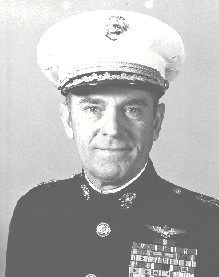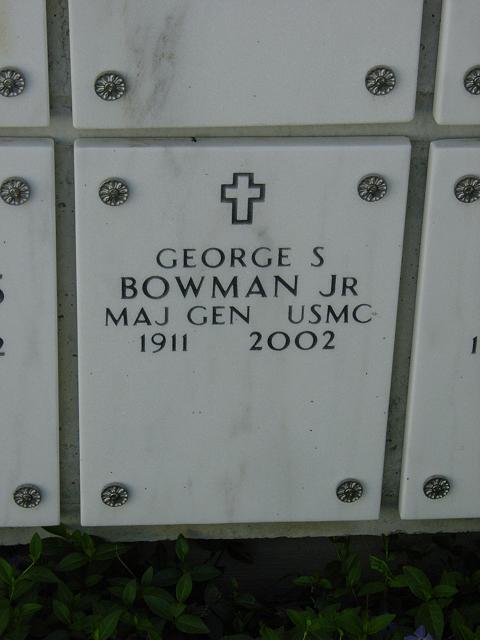Major General George S. Bowman, Jr., who served as Commanding General, Marine Corps Base, Camp Pendleton, California, from August 10, 1970 until January 1, 1972, retired February 1, 1972, after more than 35 years of active duty service.
George Shepard Bowman, Jr., was born in Hammond, Louisiana, and completed high school there. In 1931, he entered Louisiana State University, at Baton Rouge, and received a Bachelor of Science degree in Electrical Engineering upon graduation in 1936. Active in sports during his school years, he was a five-letter man at the university, participating in football and track. He was also a member of the Reserve Officers’ Training Corps unit at the university, and resigned his Army Reserve commission to accept appointment as a Marine second lieutenant, July 10, 1936.
After completing Basic School at the Philadelphia Navy Yard, Lieutenant Bowman was stationed at the Navy Yard, Pearl Harbor, Hawaii, from May 1937 until July 1938, then served with the Sixth Marines in San Diego, In February 1939, he was assigned as a student Naval aviator at the Naval Air Station, Pensacola, Florida, and was designated a Naval Aviator in December 1939. Leaving Pensacola, he reported to Quantico, Virginia, in February 1940, and was later assigned to Marine Fighter Squadron 111, Marine Aircraft Group 11. He was promoted to first lieutenant in July 1939, and to captain in October 1941.
When the United States entered World War II, he was ordered with the squadron to San Diego. In March 1942, Captain Bowman was named commander of Service Squadron 13, Marine Aircraft Group 13, and embarked with the group for American Samoa, where he served as Operations Officer of Marine Aircraft Group 13, from January 1943 until September 1943. He was promoted to major in August 1942.
Upon his return to the United States, he was assigned to the Marine Corps Air Station, Santa Barbara, California in November 1943, and was promoted to lieutenant colonel the following month. In December 1943, Lieutenant Colonel Bowman became Operations Officer, G-3, Marine Aircraft Group 42, Marine Fleet Air, West Coast, serving in this capacity until September 1944 and as Group Executive Officer until December In January 1945, he arrived at Ewa Oahu, Hawaii, as Assistant G-3, Aircraft, Fleet Marine Force, Pacific. That June he was assigned as Operations Officer on the Staff of Commander Naval Air Base, Okinawa, administering shore controlled air-sea rescue facilities. For meritorious service in this capacity and as temporary Air Base Commander, Awase, Okinawa, he was awarded the Bronze Star Medal with Combat “V”.
Following this assignment, Lieutenant Colonel Bowman rejoined Aircraft, Fleet Marine Force, Pacific, in November 1945, serving as a squadron commander with Marine Aircraft Group 15 until February 1946. In March 1946, he reported to Marine Corps Schools, Quantico, where he completed the Command and Staff Course in August 1946, then served as an instructor in the Aviation Section through May 1949. Upon leaving Quantico, he began a three-year tour of duty at Headquarters Marine Corps in June 1949, serving as Assistant Head and, later, Head, Personnel Branch, Division of Aviation. While serving in the latter capacity, he was promoted to colonel in February 1951.
Colonel Bowman was detached from Headquarters Marine Corps in July 1952 and ordered to Korea. On his arrival in Korea, he served briefly as Commanding Officer of Marine Aircraft Group 12, 1st Marine Aircraft Wing, prior to assuming his regular duties as Group Executive Officer. From January to April 1953, he again served as the group’s commander. For exceptionally meritorious conduct from August 1952 until April 1953, he was awarded the Legion of Merit with Combat “V”. The Distinguished Flying Cross was awarded him for heroism while flying an attack bomber in a massed aerial assault on enemy supply installations in the vicinity of Chinnampo, March 26, 1953.
Upon his return to Washington, D. C., in May 1953, Colonel Bowman was a member of a board studying the Marine Aviation Ground Officer Program and, in August 1953, entered the National War College as a student. He completed the course the following summer, and was transferred to Cherry Point, North Carolina, in July 1954. He served there as Chief of Staff, 2d Marine Aircraft Wing, Aircraft, Fleet Marine Force, Atlantic, until January 1956.
Colonel Bowman was assigned to Marine Corps Schools, Quantico, in February 1956, and served as Director Of the Junior School through June 1958. The following month, he returned to Headquarters Marine Corps, where he served as Deputy Assistant Director of the Division of Aviation until March 1960. In April 1960, he was assigned as Assistant Chief of Staff, J3, Staff of the Commander in Chief, Pacific, in Hawaii, and while serving in this capacity was promoted to brigadier general in July 1960. Following his service in Hawaii, General Bowman departed for the Far East and assumed duty as Assistant Wing Commanders 1st Marine Aircraft Wing, in February 1963.
Upon his return to the United States in April 1964, he reported to the 2d Marine Aircraft Wing, Cherry Point, North Carolina. He served as Assistant Wing Commander until June 1964, when he took over command of the Wing. For service in the latter capacity from June 1964 until May 1966, he was awarded a Gold Star in lieu of a second Legion of Merit. He was promoted to major general in April 1965.
From June 1966 until June 1968, General Bowman saw duty as Deputy Commander, Fleet Marine Force, Atlantic He next served for one year as Marine Corps Liaison Officer (OP-09M), Office of the Chief of Naval Operations, Washington, D.C. For his service in the latter capacity, he was awarded a Gold Star in lieu of a third Legion of Merit.
General Bowman was ordered to the Republic of Vietnam in July 1969. For exceptionally meritorious service as Deputy Commander, III Marine Amphibious Force and, later, as Deputy Commander, XXIV Corps, he earned the Distinguished Service Medal. He also earned the Korean Chung Mu; the National Order of Vietnam Knight, 5th Class; the Vietnamese Cross of Gallantry with Palm; and the Vietnamese Armed Forces Meritorious Unit Citation with Bronze Palm.
Upon his return to the United States in August 1970, General Bowman assumed his last duty assignment as Commanding General, Marine Corps Base, Camp Pendleton, California.
A complete list of his medals and decorations include: the Distinguished Service Medal; the Legion of Merit with Combat “V” and Gold Stars in lieu of second and third awards; the Distinguished Flying Cross; the Bronze Star Medal with Combat “V”; the Air Medal; the Presidential Unit Citation; the Navy Unit Commendation; the American Defense Service Medal with Base clasp; the American Campaign Medal; the Asiatic-Pacific Campaign Medal with one bronze star; the World War II Victory Medal; the Navy Occupation Service Medal with Asia clasp; the National Defense Service Medal with one bronze star; the Korean Service Medal with two bronze stars; the Vietnam Service Medal with one bronze star; the Korean Chung Mu; the National Order of Vietnam Knight, 5th Class; the Vietnamese Cross of Gallantry with Palm; the Korean Presidential Unit Citation; the Vietnamese Armed Forces Meritorious Unit Citation with Bronze Palm; the United Nations Service Medal; and the Republic of Vietnam Campaign Medal with device.
Major General Bowman passed away on 5/3/2002 and is buried in Arlington Cemetery.
BOWMAN, GEORGE S JR
MAJ GEN US MARINE CORPS
DATE OF BIRTH: 12/24/1911
DATE OF DEATH: 05/03/2002
BURIED AT: SECTION 6-Y ROW 15 SITE 1
ARLINGTON NATIONAL CEMETERY
Michael Robert Patterson was born in Arlington and is the son of a former officer of the US Army. So it was no wonder that sooner or later his interests drew him to American history and especially to American military history. Many of his articles can be found on renowned portals like the New York Times, Washingtonpost or Wikipedia.
Reviewed by: Michael Howard


